Minnesota Dragonflies and Damselflies
Order Odonata |
Odonata is the order of insects that is distinguished by a number of morphological features. Adults have minute antennae; extremely large eyes that fill most of the head; two pairs of transparent, membranous wings with many small veins; and a long slender abdomen. Nymphs (larval stage) have posterior tracheal gills and a prehensile labium (extendible jaws underneath the head). The order includes dragonflies and damselflies. There are about 6,000 Odonata species in about 600 genera in 29 families worldwide, about 460 species in 92 genera in 12 families in North America north of Mexico. Odonata Central lists 140 Odonata species in Minneosta. |

Recent Additions |
|||||
Midland clubtail |
|||||
Midland clubtail (Gomphus fraternus) is an uncommon, early season, medium-sized clubtail. It is found from early June to late July by moderately to fast flowing rivers and large streams, and by large lakes with emergent vegetation. When the adult hunts it perches on the ground or a rock on a bank or shoreline. It is a very strong flier and often patrols open water far from land. Clubtails (family Gomphidae) are distinguished by expanded abdominal segments 8 and 9 forming a “club”, clear wings with no dark patches, forewing and hindwing triangles similar in size, and eyes that do not meet at the top of the head. Midland clubtail is identified by the moderate-sized club only slightly narrower than the thorax; lack of a black horizontal stripe on the face; and lack of pale dorsal spots on abdominal segments 8 and 9. |
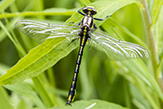 |
||||
Shadow darner |
|||||
Shadow darner (Aeshna umbrosa) is a large, common and widespread, mosaic darner. It occurs throughout North America except in the arid southwest and, for some reason, Newfoundland. It is found from late June to late October in shaded areas alongside slow streams, ponds, and swamps. Only the autumn meadowhawk flies later in the year. Adults hunt mostly in the shade and mostly at dusk. Mosaic darners are similar in size and appearance so a close examination or good photos are required for identification. This species is identified by the absence of a black horizontal stripe across the face; yellow thoracic stripes; relatively straight first thoracic stripe with an extension at the top; pale blue abdominal spots that are smaller than other other mosaic darners; wedge-type claspers on the male; and preference for flying at dusk and in the shade. |
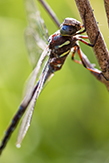 |
||||
Ebony jewelwing |
|||||
Ebony jewelwing (Calopteryx maculata) is a large, showy, broad-winged damselfly. It can be found from late May to early September near shallow, small to medium-sized, canopy covered forest streams and adjacent shaded areas. Adults live on average for 16 to 20 days. They are often noticed in large numbers but for only a short period and then sporadically or not at all until the next year. Jewelwings in Minnesota are identified by the broad, partially or wholly black wings; and on the female the small white patch near the tip of each wing. This species is identified by the brilliant metallic green or blue body; the broader, wholly black wings that are 3 times as long as wide; and the wider white patch near the wing tip of the female. |
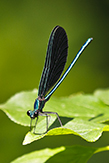 |
||||
Common green darner |
|||||
This dragonfly is the most common darner in North America. The bright green thorax and face and the large size make this the easiest of all darners to identify. Other identifying features are the black and blue “bull’s eye” between the eyes and, in warm weather on the male, bright blue lateral stripes on the thorax. In cool weather the lateral stripes fade to dark purple. In the fall juveniles flock together and migrate to the southern United States. Their offspring return the following spring. |
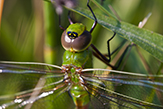 |
||||
Other Recent Additions |
|||||
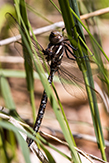 |
|||||
American emerald (Cordulia shurtleffii) |
|||||
black meadowhawk (Sympetrum danae) |
|||||
black saddlebags (Tramea lacerata) |
|||||
blue dasher (Pachydiplax longipennis) |
|||||
blue-fronted dancer (Argia apicalis) |
|||||
blue-tipped dancer (Argia tibialis) |
|||||
boreal whiteface (Leucorrhinia borealis) |
|||||
calico pennant (Celithemis elisa) |
|||||
Canada darner (Aeshna canadensis) |
|||||
common spreadwing (Lestes disjunctus) |
|||||
crimson-ringed whiteface (Leucorrhinia glacialis) |
|||||
eastern amberwing (Perithemis tenera) |
|||||
eastern band-winged meadowhawk (Sympetrum semicinctum semicinctum) |
|||||
elfin skimmer (Nannothemis bella) |
|||||
extra-striped snaketail (Ophiogomphus anomalus) |
|||||
fawn darner (Boyeria vinosa) |
|||||
forcipate emerald (Somatochlora forcipata) |
|||||
frosted whiteface (Leucorrhinia frigida) |
|||||
green-faced clubtail (Gomphus viridifrons) |
|||||
Hine's Emerald (Somatochlora hineana) |
|||||
Hudsonian whiteface (Leucorrhinia hudsonica) |
|||||
lake darner (Aeshna eremita) |
|||||
lilypad clubtail (Arigomphus furcifer) |
|||||
lyre-tipped spreadwing (Lestes unguiculatus) |
|||||
ocellated darner (Boyeria grafiana) |
|||||
powdered dancer (Argia moesta) |
|||||
pronghorn clubtail (Gomphus graslinellus) |
|||||
pygmy snaketail (Ophiogomphus howei) |
|||||
Quebec emerald (Somatochlora brevicincta) |
|||||
rapids clubtail (Gomphus quadricolor) |
|||||
river jewelwing (Calopteryx aequabilis) |
|||||
St. Croix snaketail (Ophiogomphus susbehcha) |
|||||
spiny baskettail (Epitheca spinigera) |
|||||
splendid clubtail (Gomphus lineatifrons) |
|||||
spotted spreadwing (Lestes congener) |
|||||
spot-winged glider (Pantala hymenaea) |
|||||
subarctic darner (Aeshna subarctica) |
|||||
sweetflag spreadwing (Lestes forcipatus) |
|||||
variable darner (Aeshna interrupta) |
|||||
wandering glider (Pantala flavescens) |
|||||
zigzag darner (Aeshna sitchensis) |
|||||
![]() = Profile
= Profile
![]() = Photo
= Photo
![]() = Video
= Video
No Species Page Yet?
If you do not see a linked page for an insect in the list at left you can still upload a photo or video or report a sighting for that insect. Click on one of the buttons below and type in the common name and/or scientific name of the insect in your photo, video, or sighting. A new page will be created for that insect featuring your contribution.
Capitalization of Common Names
Insect scientific names are governed by the International Commission on Zoological Nomenclature (ICZN). Vernacular (common) names are not. In an attempt to “assure the uniformity of (common) names of common insects” the Entomological Society of America (ESA) published Common Names of Insects and Related Organisms. ESA has no rule or guideline that addresses capitalization of common names. However, the database of common names published by ESA does not capitalize common names. National Center for Biotechnology Information (NCBI) also uses uncapitalized common names. Most other sources, including ITIS, BAMONA, Odonata Central, and the Peterson Field Guides, capitalize common insect names. MinnesotaSeasons.com will adhere to the convention followed by ESA and NCBI.
Last Updated:

























